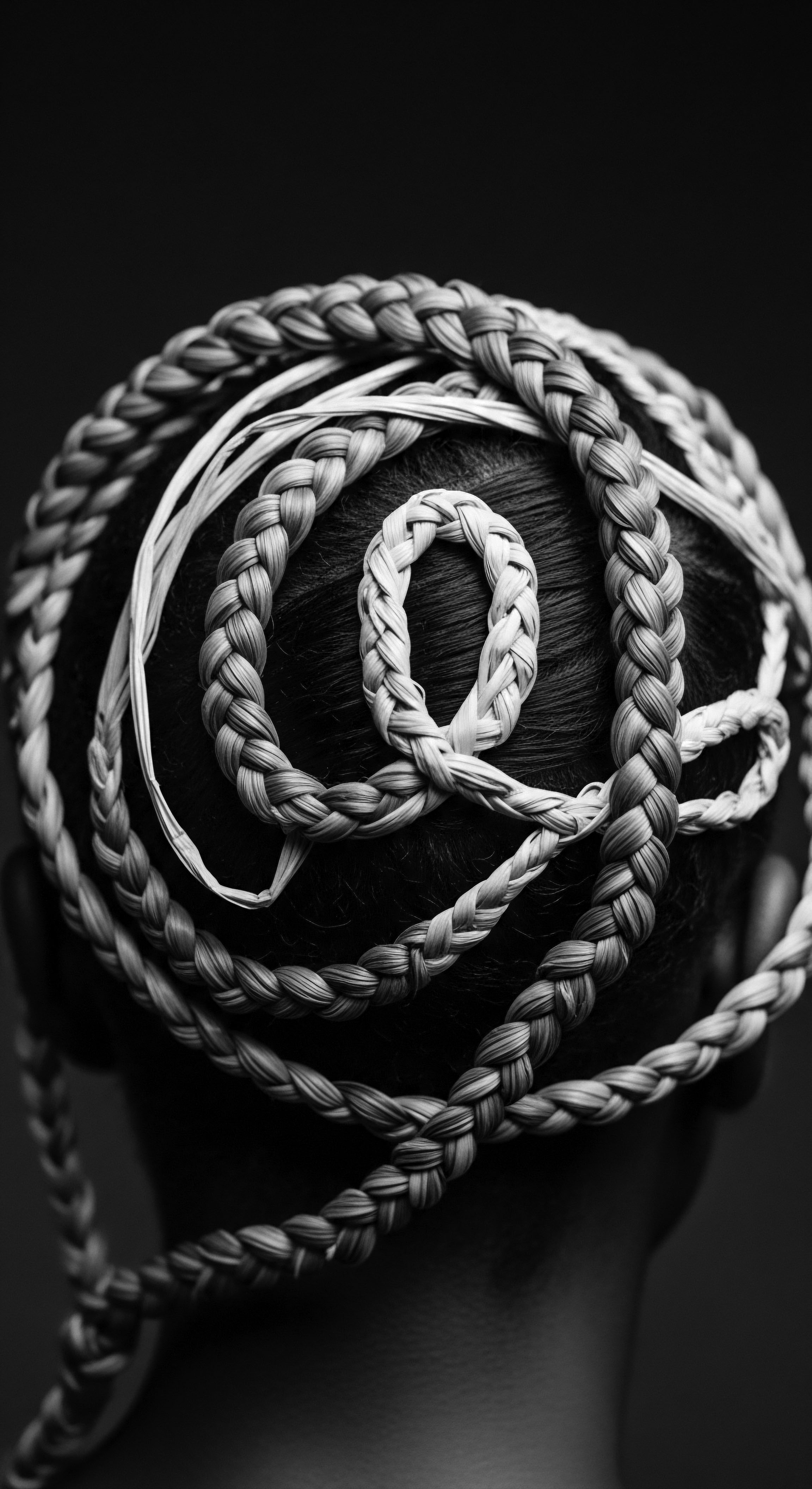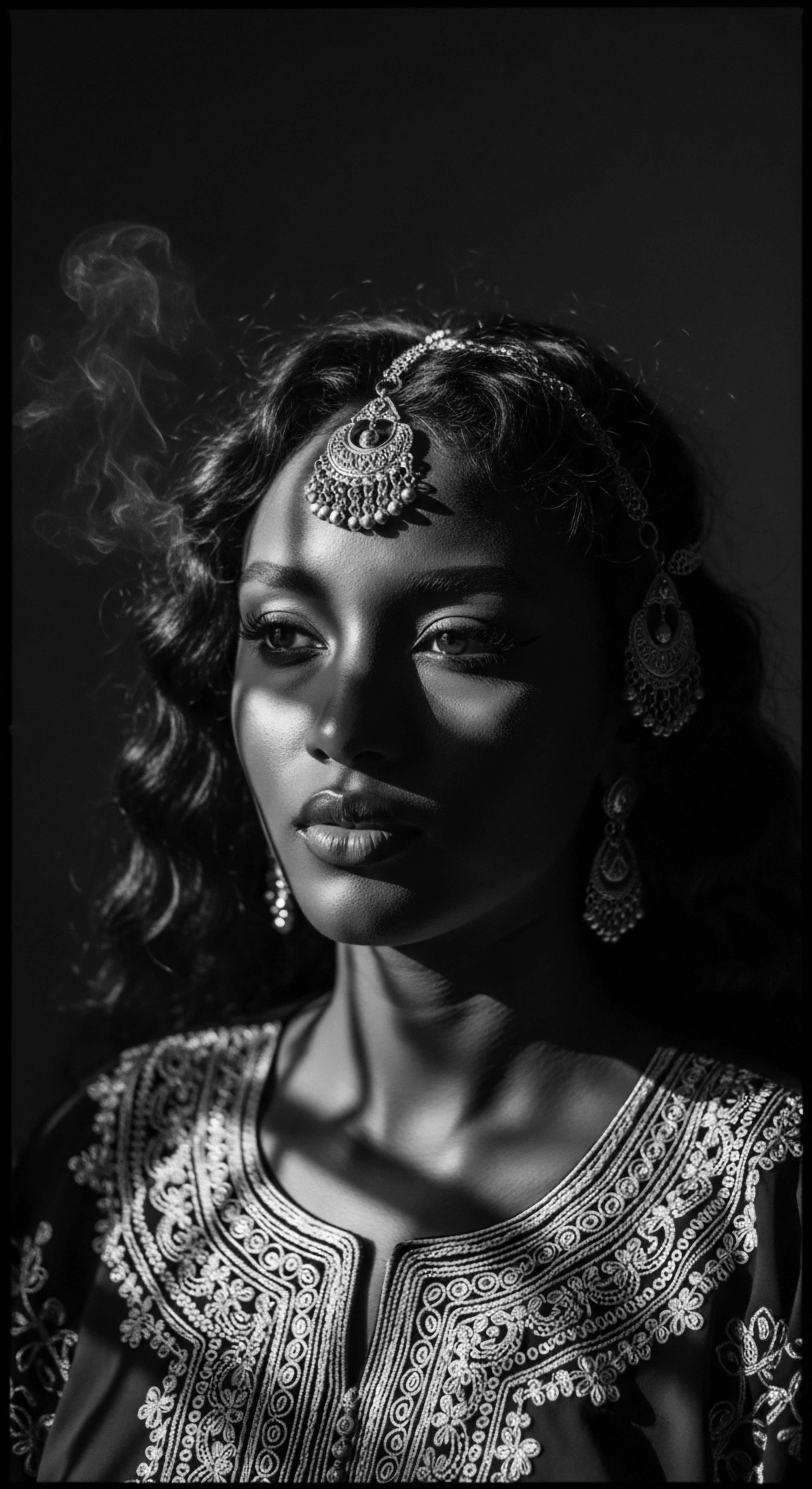
Roots
The story of textured hair is as ancient as the earth itself, written not merely in strands and coils but in the living memory passed down through generations. To truly understand its resilience, we must journey beyond the surface, beyond the fleeting trends, and trace its lineage back to the very soil from which our ancestors nourished their bodies and, by extension, their crowns. What is the historical significance of specific dietary practices for textured hair resilience? This question invites us into a deep meditation on heritage, urging us to listen to the whispers of forgotten fields and vibrant kitchens, where sustenance was not just about survival, but about a profound connection to the body’s holistic well-being.
Consider the intrinsic composition of our hair, a testament to the biological wisdom encoded within us. Hair, particularly its remarkable strength and flexibility, depends heavily on the internal environment of the body. Proteins, amino acids, vitamins, and minerals serve as the fundamental building blocks, meticulously assembled to form the keratin structures that give textured hair its unique character.
Ancestral communities, intimately connected to the rhythms of nature, understood this deeply. Their dietary practices, shaped by local ecosystems and inherited wisdom, provided the very nutrients necessary for hair to flourish, defying environmental challenges and embodying a visual declaration of health and vitality.

How Did Ancestral Diets Shape Hair’s Fundamental Structure?
The foundation of hair resilience lies in its protein content. Keratin, the primary protein composing hair fibers, relies on a steady supply of amino acids. Many traditional African diets, for instance, relied on diverse sources of plant-based proteins, such as various legumes and indigenous grains.
These staples ensured a consistent availability of the necessary amino acids. For instance, the cowpea , a resilient legume indigenous to Africa, was a widespread food source, offering substantial protein alongside essential minerals that contributed to overall bodily vigor and, consequently, robust hair.
Ancestral dietary traditions provided the fundamental building blocks for textured hair’s innate strength.
Beyond protein, a constellation of vitamins and minerals play their part. Iron , critical for oxygen transport to hair follicles, was often sourced from leafy greens and certain cuts of meat. Zinc , a cofactor in numerous enzymatic reactions vital for hair tissue growth and repair, appeared in nuts and seeds. The vibrant hues of traditional root vegetables and fruits signaled the presence of vitamins A and C , crucial for sebum production and collagen synthesis, respectively.
Sebum, the natural oil produced by the scalp, lubricates the hair shaft, providing a protective barrier. Collagen provides structural integrity to the skin, including the scalp, thereby supporting healthy hair follicles.
The availability and consumption patterns of these nutrient-rich foods were not random; they were interwoven with cultural practices, agricultural knowledge, and communal eating rituals. A deep understanding of the land and its bounty allowed these communities to sustain themselves, simultaneously nourishing their bodies and fostering the unique qualities of their textured hair. This deep lineage reminds us that hair care begins not with a product, but with the earth’s offerings, ingested and assimilated into our very being.
| Nutrient Proteins (Amino Acids) |
| Ancestral Food Sources Legumes (cowpeas, lentils), indigenous grains, certain meats |
| Hair Benefit from Heritage Perspective Forms keratin , the core structure of hair, promoting strength and reducing breakage. |
| Nutrient Iron |
| Ancestral Food Sources Leafy greens (collards, spinach), certain red meats |
| Hair Benefit from Heritage Perspective Aids oxygen transport to follicles, supporting robust hair growth cycles. |
| Nutrient Zinc |
| Ancestral Food Sources Nuts, seeds, certain root vegetables |
| Hair Benefit from Heritage Perspective Contributes to cell regeneration and tissue repair within the hair follicle. |
| Nutrient Vitamin A (Beta-Carotene) |
| Ancestral Food Sources Sweet potatoes, carrots, leafy greens |
| Hair Benefit from Heritage Perspective Supports scalp health and sebum production for natural moisture. |
| Nutrient Vitamin C |
| Ancestral Food Sources Citrus fruits, berries, certain vegetables |
| Hair Benefit from Heritage Perspective Assists in collagen formation, which strengthens hair shafts and reduces brittleness. |
| Nutrient Omega-3 Fatty Acids |
| Ancestral Food Sources Certain fish, flaxseeds, walnuts (where available) |
| Hair Benefit from Heritage Perspective Contributes to scalp hydration and overall hair flexibility. |
| Nutrient These nutritional components, widely present in diverse ancestral diets, laid the foundation for the inherent resilience of textured hair. |
The connection between a land’s produce and its people’s hair tells a compelling story. Where indigenous diets were varied and nutrient-dense, hair often mirrored that richness, exhibiting vitality and strength. This is particularly relevant for understanding the genetic predispositions of textured hair, which, while beautiful in its varied curl patterns, can also be prone to dryness and breakage due to its structural characteristics.
A consistently nourishing diet from childhood would have provided a crucial internal defense, helping to mitigate these tendencies and promote long, healthy strands. This foundational understanding, rooted in ecological harmony, illuminates the deep heritage of hair strength from within.

Ritual
The journey of textured hair is not solely biological; it is profoundly ritualistic, a living testament to practices passed from elder to child, steeped in collective memory. The routines of styling, detangling, and adornment are not mere aesthetic choices. They are echoes of ancient wisdom, each motion a conversation with heritage.
What is the historical significance of specific dietary practices for textured hair resilience in the context of these care rituals? A deep examination reveals how sustenance, both internal and external, played a pivotal role in enabling these traditions and shaping the very definition of hair beauty.
For generations, particularly within Black and mixed-race communities, hair care has been a communal affair, a space of intimacy, storytelling, and shared knowledge. The health of the hair, fundamentally supported by diet, allowed for the elaborate protective styles and cultural expressions that defined identity across diverse African societies. Consider the intricate braiding patterns of various West African peoples, or the towering, sculpted styles of East African tribes.
Such styles demanded hair that possessed not only length but also elasticity and minimal breakage, qualities directly influenced by the availability of essential nutrients. Without hair strong enough to endure the tension of braiding or the manipulation involved in coiling, these artistic expressions would have been difficult to maintain, if not impossible.

How did ancestral nutrition support protective hair styling?
The concept of “protective styling” holds ancient roots, far predating its modern terminology. These styles—braids, twists, and coils, often adorned with cowrie shells, beads, or precious metals—were not simply decorative. They shielded delicate strands from environmental elements such as harsh sun or dry air, minimized tangling, and reduced daily manipulation. The ability to perform and maintain these styles, thereby preserving hair length and health over time, relied heavily on the hair’s internal integrity.
A diet rich in biotin , a B-vitamin vital for keratin structure, would have produced hair that was less prone to brittleness and more pliable for intricate styling. Foods like certain nuts, seeds, and root vegetables would have supplied this crucial nutrient in ancestral diets.
The vitality imparted by a nourishing diet was fundamental to the successful execution of heritage styling practices.
The hair’s natural oils, often stimulated by nutrient-rich diets, further aided in these rituals. Traditional practices often involved pressing natural oils and butters into the hair, a custom that was augmented by the body’s own healthy sebum production. A diet abundant in omega-3 fatty acids , found in sources like certain wild-caught fish or seeds, contributed to scalp health and natural oil balance, making the hair more supple and less prone to dryness, which is a common concern for textured hair. This internal lubrication would have made the detangling and styling processes gentler, reducing strain on the hair shaft.
The connection between diet and hair’s tactile qualities is also significant. Hair that is well-nourished from within tends to possess a certain softness and elasticity. This allowed for the creation of styles that could withstand long periods, reducing the need for constant manipulation and thereby minimizing mechanical damage. The practices of communal hair grooming, described in historical accounts, were moments of bonding, facilitated by hair that was cooperative and resilient, a direct outcome of holistic internal nourishment.
- Chebe Powder Tradition ❉ The Basara women of Chad are known for their practice of using a mixture of Chebe powder (a blend of local herbs), oils, and animal fats. While this is an external application, their long, resilient hair is also attributed to a lifestyle and diet that supported overall health. This external ritual complements, rather than replaces, the internal nourishment essential for hair capable of retaining such length and strength.
- Millet-Based Diets ❉ In certain regions of West Africa, millet and sorghum were dietary staples. These grains are rich in B vitamins , iron , and zinc , all of which support hair growth and strength. The consistent consumption of such foods would have provided a robust internal foundation for hair resilience, enabling the intricate and often voluminous styles observed in these communities.
- Ethiopian Hair Butter ❉ Some Ethiopian and Somali women traditionally used a homemade “hair butter” from whipped animal milk and water. This practice, alongside their dietary habits, contributed to hair maintenance and resilience. The nutritional intake from their diets, often including various dairy products and protein-rich staples, would have complemented the external application, creating a holistic approach to hair health.
The very artistry of textured hair styling, across its historical breadth, presupposes a certain level of hair health and durability. This durability, in turn, points directly back to the dietary practices that fueled the body’s ability to produce strong, resilient strands. The rituals of hair care and styling, then, become a mirror reflecting the deeper traditions of ancestral nourishment.

Relay
The heritage of textured hair is a living archive, continuously passed down through generations, embodying collective wisdom and the enduring spirit of communities. Our exploration of what is the historical significance of specific dietary practices for textured hair resilience must now consider this intergenerational relay—how knowledge of internal nourishment was preserved, adapted, and sometimes lost, influencing the very identity and self-perception tied to our crowns. This deep analysis moves beyond mere nutrients, considering the cultural forces that shaped food choices and their lasting impact on hair health within the Black and mixed-race diaspora.
The concept of holistic well-being, where the health of the body, mind, and spirit are inextricably linked, formed the bedrock of ancestral philosophies. Hair was never viewed in isolation; its condition was a direct barometer of inner vitality. Thus, dietary practices were not segmented as “hair food” but as fundamental nourishment for the entire being.
This integrated perspective, often obscured by modern compartmentalized health approaches, is a significant aspect of our heritage that deserves profound re-examination. The continuity of traditional foodways, even in the face of immense disruption, speaks volumes about their perceived efficacy and cultural value.

How did forced migration affect ancestral dietary practices and hair health?
The transatlantic slave trade represents a catastrophic rupture in the transmission of ancestral knowledge, including dietary practices. Enslaved Africans were violently severed from their indigenous food systems, forced to subsist on inadequate and unfamiliar provisions. The dramatic shift from nutrient-dense, locally sourced diets to meager rations often led to widespread nutritional deficiencies. These deficiencies directly impacted hair health, contributing to thinning, breakage, and a loss of vitality.
What was once a symbol of vigor and beauty became, for many, a source of struggle and a visible marker of systemic oppression. (Byrd & Tharps, 2001)
The disruption of ancestral diets profoundly impacted hair health, a physical testament to resilience in the face of adversity.
Despite these brutal conditions, a remarkable resilience persisted. Enslaved communities adapted, cultivating what little land they could, integrating new-world crops, and holding onto vestiges of their culinary heritage. The powerful narrative of enslaved people braiding seeds into their hair to transport them during forced migrations serves as a potent reminder of this resourcefulness and the deep connection between food, hair, and survival. These seeds, often rice, beans, or various grains, were not merely sustenance for the body but carried the potential to recreate familiar foodways and, by extension, support bodily health, including hair resilience, in new, hostile environments.
As communities adapted, certain foods became cornerstones of diasporic diets, not only for their availability but also for their ability to provide critical nutrients. For instance, collard greens , a staple in many Southern American diets, share nutritional similarities with leafy greens common in various African cuisines, providing vitamins A and C. Black-eyed peas and red beans , though different varieties, offered the protein and iron that cowpeas once did. These substitutions, while pragmatic, allowed for a partial continuation of a nutrient profile that historically supported textured hair.

What modern research validates the impact of traditional diets on textured hair resilience?
Contemporary nutritional science increasingly validates the wisdom embedded in these ancestral foodways. Studies on the role of specific macronutrients and micronutrients in hair health continually point to the very elements abundant in traditional diets. Proteins, complex carbohydrates, healthy fats, and a spectrum of vitamins and minerals are consistently highlighted as essential for robust hair growth and resilience, particularly for textured hair, which can be prone to dryness and brittleness.
For example, a diet rich in omega-3 fatty acids —found in sources like salmon, flaxseeds, and walnuts—has been shown to hydrate the scalp and hair, promoting suppleness. This directly addresses a primary challenge for textured hair ❉ maintaining moisture. Similarly, the B vitamins , especially biotin , found in eggs, sweet potatoes, and almonds, contribute to keratin structure, which is crucial for the strength of each hair strand. Iron, prevalent in dark leafy greens and certain meats, supports healthy blood flow to the follicles, ensuring they receive necessary nutrients for growth.
- Protein Sources ❉ Traditional diets in many African and diasporic communities often incorporated a variety of protein sources beyond meat. For instance, legumes (such as black beans and lentils) were, and continue to be, staple sources of protein, zinc, and iron, all vital for hair growth and strength. (Aboh, 2023),
- Vitamin-Rich Produce ❉ The historical emphasis on diverse root vegetables (like sweet potatoes, rich in beta-carotene for Vitamin A) and leafy greens (providing Vitamins A and C) directly supported hair moisture and collagen production, benefiting the scalp and hair fiber. (Aboh, 2023),
- Healthy Fats ❉ While often associated with modern health trends, the inclusion of naturally occurring healthy fats from seeds, nuts, and certain animal sources in traditional diets provided omega-3s , contributing to scalp health and hair sheen.
The interplay of these nutrients, consumed in a balanced and consistent manner as part of a holistic diet, created an internal environment conducive to the natural resilience of textured hair. This deep connection between daily sustenance and hair vitality stands as a profound legacy, one that continues to inform modern approaches to textured hair care, urging a return to foundational principles rooted in our collective past. The wisdom of these historical dietary practices offers a pathway to not just stronger hair, but a deeper connection to our heritage.

Reflection
As the light fades on our exploration of textured hair heritage, we stand at the nexus of past and present, witnessing how the echoes of ancestral dietary practices continue to ripple through the very strands that crown us. The resilience of textured hair, a narrative often told through stories of strength and beauty, finds a profound, grounding truth in the sustenance that once nourished our forebears. It is a story not of simple recipes, but of an intricate dance between the earth’s generosity and human ingenuity, a dance that directly contributed to the structural integrity and vibrant life of hair that has endured generations.
To truly honor the ‘Soul of a Strand’ is to recognize that our hair carries not only genetic codes but also the living memory of a heritage deeply intertwined with the foods consumed. Each coil, each curve, can be seen as a testament to the wisdom that understood the profound link between what entered the body and the vibrancy that emanated from it. This understanding compels us to consider our own contemporary choices, inviting us to seek a balance that respects both ancestral traditions and current scientific knowledge.
The resilience of textured hair, so often attributed to external care, is rooted just as deeply in the internal landscape shaped by diet. It is a legacy of nourishment, a testament to communities who, through their relationship with the land and their culinary wisdom, gifted future generations with a foundation of strength. Our journey through these historical dietary practices is more than an academic exercise; it is an invitation to reconnect with a heritage that promises not only healthier hair but a richer, more holistic well-being.

References
- Aboh, Abisola. “Nourishing Your Crown ❉ The Best Foods for Afro-Textured Hair Growth.” Full Bloom Beauty, 2023.
- Byrd, Ayana D. and Lori L. Tharps. Hair Story ❉ Untangling the Roots of Black Hair in America. St. Martin’s Press, 2001.
- Collins, M. A. The Black Hair Handbook ❉ A Natural Hair Care Guide for Coily, Kinky, & Textured Hair. CreateSpace Independent Publishing Platform, 2018.
- Irobi, Amarachi. “Here are 10 Magical Foods For Hair Growth.” My Afro Hair, 2023.
- Koppelman, Susan. The Hair on Her Head. Feminist Press at CUNY, 1996.
- McMichael, Amy J. “Hair Aging in Different Races and Ethnicities.” The Journal of Clinical and Aesthetic Dermatology, vol. 11, no. 12, 2018, pp. 29-34.
- Springfield, S. J. et al. “Unique Stress, Cultural Resources, and Psychological Resilience in Young African American Women ❉ Insights for Effective Intervention and CVD Prevention.” MDPI, 2023.
- Trüeb, Ralph M. “The Hair Cycle and Its Relation to Nutrition.” ResearchGate, 2020.
